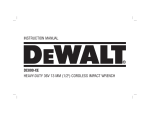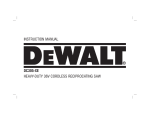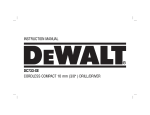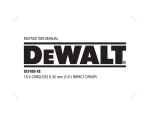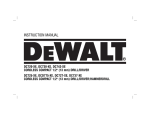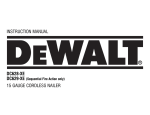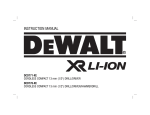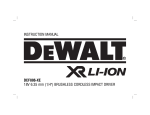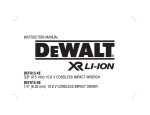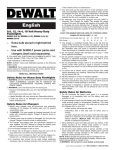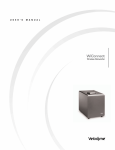Download DeWalt DW059-XE Instruction manual
Transcript
DW052-XE, DW054-XE, DW056-XE CORDLESS IMPACT DRIVER DW057-XE, DW059-XE 12.7MM (1/2") CORDLESS IMPACT WRENCH INSTRUCTION MANUAL DEWALT Industrial Tool Co., 701 East Joppa Road, Baltimore, MD 21286 • 20 Fletcher Road, Mooroolbark, VIC 3138 Australia (OCT05) Form No. 638495-00 DW052-XE, DW054-XE, DW056-XE, DW057-XE, DW059-XE Copyright © 2004, 2005 DEWALT The following are trademarks for one or more DEWALT power tools: the yellow and black color scheme; the “D” shaped air intake grill; the array of pyramids on the handgrip; the kit box configuration; and the array of lozenge-shaped humps on the surface of the tool. IF YOU HAVE ANY QUESTIONS OR COMMENTS ABOUT THIS OR ANY DEWALT TOOL, CALL US AT: 1800 654 155 (Aust) or 09 526 2556 (NZ). SAFETY INSTRUCTIONS FOR POWER TOOLS When using power tools, always observe the safety regulations applicable in your country to reduce the risk of fire, electric shock and personal injury. Read the following safety instructions before attempting to operate this product. Keep these instructions in a safe place. General Safety Rules WARNING! Read all instructions. Failure to follow all instructions listed below may result in electric shock, fire and/or serious injury. The term “power tool” in all of the warnings listed below refers to your mains operated (corded) power tool or battery operated (cordless) power tool. SAVE THESE INSTRUCTIONS 1. WORK AREA a. Keep work area clean and well lit. Cluttered and dark areas invite accidents. b. Do not operate power tools in explosive atmospheres, such as in the presence of flammable liquids, gases or dust. Power tools create sparks which may ignite the dust or fumes. c. Keep children and bystanders away while operating a power tool. Distractions can cause you to lose control. 2. ELECTRICAL SAFETY a. Power tool plugs must match the outlet. Never modify the plug in any way. Do not use any adapter plugs with earthed (grounded) power tools. Unmodified plugs and matching outlets will reduce risk of electric shock. b. Avoid body contact with earthed or grounded surfaces such as pipes, radiators, ranges and refrigerators. There is an increased risk of electric shock if your body is earthed or grounded. c. Do not expose power tools to rain or wet conditions. Water entering a power tool will increase the risk of electric shock. d. Do not abuse the cord. Never use the cord for carrying, pulling or unplugging the power tool. Keep cord away from heat, oil, sharp edges or moving parts. Damaged or entangled cords increase the risk of electric shock. e. When operating a power tool outdoors, use an extension cord suitable for outdoor use. Use of a cord suitable for outdoor use reduces the risk of electric shock. 3. PERSONAL SAFETY a. Stay alert, watch what you are doing and use common sense when operating a power tool. Do not use a power tool while you are tired or under the influence of drugs, alcohol or medication. A moment of inattention while operating power tools may result in serious personal injury. b. Use safety equipment. Always wear eye protection. Safety equipment such as dust mask, non-skid safety shoes, hard hat, or hearing protection used for appropriate conditions will reduce personal injuries. c. Avoid accidental starting. Ensure the switch is in the off position before plugging in. Carrying power tools with your finger on the switch or plugging in power tools that have the switch on invites accidents. d. Remove any adjusting key or wrench before turning the power tool on. A wrench or a key left attached to a rotating part of the power tool may result in personal injury. e. Do not overreach. Keep proper footing and balance at all times. This enables better control of the power tool in unexpected situations. f. Dress properly. Do not wear loose clothing or jewellery. Keep your hair, clothing and gloves away from moving parts. Loose clothes, jewellery or long hair can be caught in moving parts. g. If devices are provided for the connection of dust extraction and collection facilities, ensure these are connected and properly used. Use of these devices can reduce dust related hazards. 4. POWER TOOL USE AND CARE a. Do not force the power tool. Use the correct power tool for your application. The correct power tool will do the job better and safer at the rate for which it was designed. b. Do not use the power tool if the switch does not turn it on and off. Any power tool that cannot be controlled with the switch is dangerous and must be repaired. c. Disconnect the plug from the power source before making any adjustments, changing accessories, or storing power tools. Such preventive safety measures reduce the risk of starting the power tool accidentally. d. Store idle power tools out of the reach of children and do not allow persons unfamiliar with the power tool or these instructions to operate the power tool. Power tools are dangerous in the hands of untrained users. e. Maintain power tools. Check for misalignment or binding of moving parts, breakage of parts and any other condition that may affect the power tools operation. If damaged, have the power tool repaired before use. Many accidents are caused by poorly maintained power tools. f. Keep cutting tools sharp and clean. Properly maintained cutting tools with sharp cutting edges are less likely to bind and are easier to control. g. Use the power tool, accessories and tool bits etc., in accordance with these instructions and in the manner intended for the particular type of power tool, taking into account the working conditions and the work to be performed. Use of the power tool for operations different from those intended could result in a hazardous situation. 5. BATTERY TOOL USE AND CARE a. Ensure the switch is in the off position before inserting battery pack. Inserting the battery pack into power tools that have the switch on invites accidents. b. Recharge only with the charger specified by the manufacturer. A charger that is suitable for one type of battery pack may create a risk of fire when used with another battery pack. c. Use power tools only with specifically designated battery packs. Use of any other battery packs may create a risk of injury and fire. d. When battery pack is not in use, keep it away from other metal objects like paper clips, coins, keys, nails, screws, or other small metal objects that can make a connection from one terminal to another. Shorting the battery terminals together may cause burns or a fire. e. Under abusive conditions, liquid may be ejected from the battery; avoid contact. If contact accidentally occurs, flush with water. If liquid contacts eyes, additionally seek medical help. Liquid ejected from the battery may cause irritation or burns. 6. SERVICE a. Have your power tool serviced by a qualified repair person using only identical replacement parts. This will ensure that the safety of the power tool is maintained. Electrical Safety The electric motor has been designed for one voltage only. Always check that the power supply corresponds to the voltage on the rating plate. 240 V AC means your tool will operate on alternating current. As little as 10% lower voltage can cause loss of power and can result in overheating. All DEWALT tools are factory tested; if this tool does not operate, check the power supply. Your DEWALT tool is double insulated, therefore no earth wire is required. • Young children and the infirm. This appliance is not intended for use by young children or infirm persons without supervision. Young children should be supervised to ensure that they do not play with this appliance. • Replacement of the supply cord. If the supply cord is damaged, it must be replaced by the manufacturer or an authorised DEWALT Service Centre in order to avoid a hazard. Extension Cords CAUTION: Use only extension cords that are approved by the country’s Electrical Authority. Before using extension cords, inspect them for loose or exposed wires, damaged insulation and defective fittings. Replace the cord if necessary. Additional Safety Instructions • Hold tool by insulated gripping surfaces when performing an operation where the cutting tool may contact hidden wiring. Contact with a “live” wire will make exposed metal parts of the tool “live” and shock the operator. • Wear safety goggles or other eye protection. Hammering and drilling operations cause chips to fly. Flying particles can cause permanent eye damage. • Bits, sockets and tools get hot during operation. Wear gloves when touching them. • Do not operate this tool for long periods of time. Vibration caused by tool action may be harmful to your hands and arms. Use gloves to provide extra cushion and limit exposure by taking frequent rest periods. WARNING: Some dust created by power sanding, sawing, grinding, drilling, and other construction activities contains chemicals known to cause cancer, birth defects or other reproductive harm. Some examples of these chemicals are: • lead from lead-based paints, • crystalline silica from bricks and cement and other masonry products, and • arsenic and chromium from chemically-treated lumber (CCA). Your risk from these exposures varies, depending on how often you do this type of work. To reduce your exposure to these chemicals: work in a well ventilated area, and work with approved safety equipment, such as those dust masks that are specially designed to filter out microscopic particles. • Avoid prolonged contact with dust from power sanding, sawing, grinding, drilling, and other construction activities. Wear protective clothing and wash exposed areas with soap and water. Allowing dust to get into your mouth, eyes, or lay on the skin may promote absorption of harmful chemicals. WARNING: Use of this tool can generate and/or disburse dust, which may cause serious and permanent respiratory or other injury. Always use NIOSH/OSHA approved respiratory protection appropriate for the dust exposure. Direct particles away from face and body. CAUTION: When not in use, place tool on its side on a stable surface where it will not cause a tripping or falling hazard. Some tools with large battery packs will stand upright on the battery pack but may be easily knocked over. CAUTION: Wear appropriate personal hearing protection during use. Under some conditions and duration of use, noise from this product may contribute to hearing loss. • The label on your tool may include the following symbols. The symbols and their definitions are as follows: V ................volts A ..............amperes Hz................hertz W ..............watts min..............minutes ..........alternating current no..............no load speed ..........direct current ..............Class II Construction ............earthing terminal ..............safety alert symbol .../min........revolutions per minute Important Safety Instructions for Battery Packs Your tool uses a DEWALT battery pack. When ordering replacement battery packs, be sure to include catalog number and voltage. Extended Run-Time battery packs deliver more run-time than standard battery packs. Consult the chart at the end of this manual for compatibility of chargers and battery packs. NOTE: Your tool will accept either standard or Extended Run Time battery packs. However, be sure to select proper voltage. Batteries slowly lose their charge when they are not on the charger, the best place to keep your battery is on the charger at all times. The battery pack is not fully charged out of the carton. Before using the battery pack and charger, read the safety instructions below. Then follow charging procedures outlined. READ ALL INSTRUCTIONS • Do not incinerate the battery pack even if it is severely damaged or is completely worn out. The battery pack can explode in a fire. • A small leakage of liquid from the battery pack cells may occur under extreme usage or temperature conditions. This does not indicate a failure. However, if the outer seal is broken and this leakage gets on your skin: a. Wash quickly with soap and water. b. Neutralize with a mild acid such as lemon juice or vinegar. c. If battery liquid gets into your eyes, flush them with clean water for a minimum of 10 minutes and seek immediate medical attention. (Medical Note: The liquid is 25–35% solution of potassium hydroxide.) • Charge the battery packs only in DEWALT chargers. • DO NOT splash or immerse in water or other liquids. • Do not store or use the tool and battery pack in locations where the temperature may reach or exceed 105°F (40˚C) (such as outside sheds or metal buildings in summer). DANGER: Never attempt to open the battery pack for any reason. If battery pack case is cracked or damaged, do not insert into charger. Electric shock or electrocution may result. Damaged battery packs should be returned to service center for recycling. NOTE: Battery storage and carrying caps are provided for use whenever the battery is out of the tool or charger. Remove cap before placing battery in charger or tool. WARNING: Do not store or carry battery so that metal objects can contact exposed battery terminals. For example, do not place battery in aprons, pockets, tool boxes, product kit boxes, drawers, etc. with loose nails, screws, keys, etc. without battery cap. Without cap in place, battery could short circuit causing fire or burns or damage to battery. CAUTION: Battery pack must be securely attached to tool. If battery pack is detached, personal injury may result. The RBRC™ Seal The RBRC™ (Rechargeable Battery Recycling Corporation) Seal on the nickel-cadmium battery (or battery pack) indicates that the costs to recycle the battery (or battery pack) at the end of its useful life have already been paid by DEWALT. In some areas, it is illegal to place spent nickel-cadmium batteries in the trash or municipal solid waste stream and the RBRC program provides an environmentally conscious alternative. RBRC™ in cooperation with DEWALT and other battery users, has established programs in the United States to facilitate the collection of spent nickel-cadmium batteries. Help protect our environment and conserve natural resources by returning the spent nickel-cadmium battery to an authorized DEWALT service center or to your local retailer for recycling. You may also contact your local recycling center for information on where to drop off the spent battery. RBRC™ is a registered trademark of the Rechargeable Battery Recycling Corporation. Important Safety Instructions for Battery Chargers SAVE THESE INSTRUCTIONS: This manual contains important safety instructions for battery chargers. • Before using charger, read all instructions and cautionary markings on charger, battery pack, and product using battery pack. DANGER: 240 volts are present at charging terminals. Do not probe with conductive objects. Electric shock or electrocution may result. WARNING: Do not allow any liquid to get inside charger. Electric shock may result. CAUTION: To reduce the risk of injury, charge only DEWALT nickel cadmium rechargeable batteries. Other types of batteries may burst causing personal injury and damage. FIG. 1 HOT/COLD PACK DELAY Some chargers have a Hot/Cold Pack Delay feature: when the charger detects a battery that is hot, it automatically starts a Hot Pack Delay, suspending charging until the battery has cooled. After the battery has cooled, the charger automatically switches to the Pack Charging mode. This feature ensures maximum battery life. The red light flashes long, then short while in the Hot Pack Delay mode. FIG. 3 FIG. 2 RELEASE BUTTONS FIG. 4 DEPRESS BUTTON ON OPPOSITE SIDE FOR FORWARD B PROBLEM POWER LINE Some chargers have a Problem Power Line indicator. When the charger is used with some portable power sources such as generators or sources that convert DC to AC, the charger may temporarily suspend operation, flashing the red light with two fast blinks followed by a pause. This indicates the power source is out of limits. LEAVING THE BATTERY PACK IN THE CHARGER The charger and battery pack can be left connected with the red light glowing indefinitely. The charger will keep the battery pack fresh and fully charged. NOTE: A battery pack will slowly lose its charge when kept out of the charger. If the battery pack has not been kept on maintenance charge, it may need to be recharged before use. A battery pack may also slowly lose its charge if left in a charger that is not plugged into an appropriate AC source. WEAK BATTERY PACKS: Chargers can also detect a weak battery. Such batteries are still usable but should not be expected to perform as much work. In such cases, about 10 seconds after battery insertion, the charger will beep rapidly 8 times to indicate a weak battery condition. The charger will then go on to charge the battery to the highest capacity possible. Important Charging Notes VARIABLE SPEED TRIGGER SWITCH DEPRESS FOR REVERSE FIG. 5 FIG. 6 D SLEEVE C CAUTION: Under certain conditions, with the charger plugged in to the power supply, the exposed charging contacts inside the charger can be shorted by foreign material. Foreign materials of a conductive nature such as, but not limited to, steel wool, aluminum foil, or any buildup of metallic particles should be kept away from charger cavities. Always unplug the charger from the power supply when there is no battery pack in the cavity. Unplug charger before attempting to clean. • DO NOT attempt to charge the battery pack with any chargers other than the ones in this manual. The charger and battery pack are specifically designed to work together. • These chargers are not intended for any uses other than charging DEWALT rechargeable batteries. Any other uses may result in risk of fire, electric shock or electrocution. • Do not expose charger to rain or snow. • Pull by plug rather than cord when disconnecting charger. This will reduce risk of damage to electric plug and cord. • Make sure that cord is located so that it will not be stepped on, tripped over, or otherwise subjected to damage or stress. • Do not use an extension cord unless it is absolutely necessary. Use of improper extension cord could result in risk of fire, electric shock, or electrocution. • An extension cord must have adequate wire size (AWG or American Wire Gauge) for safety. The smaller the gauge number of the wire, the greater the capacity of the cable, that is 16 gauge has more capacity than 18 gauge. When using more than one extension to make up the total length, be sure each individual extension contains at least the minimum wire size. Recommended Minimum Wire Size for Extension Cords Total Length of Cord 25 ft. 50 ft. 75 ft. 100 ft. 125 ft. 150 ft. 175 ft. 7.6 m 15.2 m 22.9 m 30.5 m 38.1 m 45.7 m 53.3 m Wire Size AWG 18 18 16 16 14 14 12 • Do not place any object on top of charger or place the charger on a soft surface that might block the ventilation slots and result in excessive internal heat. Place the charger in a position away from any heat source. The charger is ventilated through slots in the top and the bottom of the housing. • Do not operate charger with damaged cord or plug — have them replaced immediately. • Do not operate charger if it has received a sharp blow, been dropped, or otherwise damaged in any way. Take it to an authorized service center. • Do not disassemble charger; take it to an authorized service center when service or repair is required. Incorrect reassembly may result in a risk of electric shock, electrocution or fire. • Disconnect the charger from the outlet before attempting any cleaning. This will reduce the risk of electric shock. Removing the battery pack will not reduce this risk. • NEVER attempt to connect 2 chargers together. • The charger is designed to operate on standard household electrical power (240 Volts). Do not attempt to use it on any other voltage. This does not apply to the vehicular charger. Using Automatic Tune-Up™ Mode The Automatic Tune-Up™ Mode equalizes or balances the individual cells in the battery pack allowing it to function at peak capacity. Battery packs should be tuned up weekly or after 10 charge/discharge cycles or whenever the pack no longer delivers the same amount of work. To use the Automatic Tune-Up™, place the battery pack in the charger and leave it for at least 8 hours. The charger will cycle through the following modes. 1. The red light will blink continuously indicating that the 1-hour charge cycle has started. 2. When the 1-hour charge cycle is complete, the light will stay on continuously and will no longer blink. This indicates that the pack is fully charged and can be used at this time. 3. Whenever the pack is left in the charger after the initial 1-hour charge, the charger will begin the Automatic Tune-Up™ Mode. This mode continues up to 8 hours or until the individual cells in the battery pack are equalized. The battery pack is ready for use and can be removed at any time during the Tune-Up™ Mode. 4. Once the Automatic Tune-Up™ Mode is complete the charger will transition to a maintenance charge; the indicator light shuts off when the automatic Tune-Up™ Mode is complete. SAVE THESE INSTRUCTIONS FOR FUTURE USE Chargers Your tool uses a 7.2, 9.6, 12.0, 14.4, or 18.0 Volt DEWALT charger. Your battery can be charged in DEWALT 1 Hour Chargers, 15 Minute Chargers or Vehicular 12 Volt Charger. Be sure to read all safety instructions before using your charger. Consult the chart at the end of this manual for compatibility of chargers and battery packs. Charging Procedure (Fig. 1) DANGER: 240 volts are present at charging terminals. Do not probe with conductive objects. Electric shock or electrocution may result. 1. Plug the charger into an appropriate outlet before inserting battery pack. 2. Insert the battery pack into the charger, as shown in Figure 1, making sure the pack is fully seated. The red (charging) light will blink continuously indicating that the charging process has started. 3. The completion of charge will be indicated by the red light remaining ON continuously. The pack is fully charged and may be used at this time or left in the charger. Indicator Light Operation PACK CHARGING................... FULLY CHARGED................... HOT/COLD PACK DELAY........ REPLACE PACK...................... PROBLEM POWER LINE........ Charge Indicators Some chargers are designed to detect certain problems that can arise with battery packs. Problems are indicated by the red light flashing at a fast rate. If this occurs, reinsert battery pack into the charger. If the problem persists, try a different battery pack to determine if the charger is OK. If the new pack charges correctly, then the original pack is defective and should be returned to a service center or other collection site for recycling. If the new battery pack elicits the same trouble indication as the original, have the charger tested at an authorized service center. 1. Longest life and best performance can be obtained if the battery pack is charged when the air temperature is between 65°F and 75°F (18°- 24°C). DO NOT charge the battery pack in an air temperature below +40°F (+4.5°C), or above +105°F (+40.5°C). This is important and will prevent serious damage to the battery pack. 2. The charger and battery pack may become warm to touch while charging. This is a normal condition, and does not indicate a problem. To facilitate the cooling of the battery pack after use, avoid placing the charger or battery pack in a warm environment such as in a metal shed, or an uninsulated trailer. 3. If the battery pack does not charge properly: a. Check current at receptacle by plugging in a lamp or other appliance b. Check to see if receptacle is connected to a light switch which turns power off when you turn out the lights. c. Move charger and battery pack to a location where the surrounding air temperature is approximately 65°F - 75°F (18° - 24°C). d. If charging problems persist, take the tool, battery pack and charger to your local service center. 4. The battery pack should be recharged when it fails to produce sufficient power on jobs which were easily done previously. DO NOT CONTINUE to use under these conditions. Follow the charging procedure. You may also charge a partially used pack whenever you desire with no adverse affect on the battery pack. 5. Under certain conditions, with the charger plugged into the power supply, the exposed charging contacts inside the charger can be shorted by foreign material. Foreign materials of a conductive nature such as, but not limited to, steel wool, aluminum foil, or any buildup of metallic particles should be kept away from charger cavities. Always unplug the charger from the power supply when there is no battery pack in the cavity. Unplug charger before attempting to clean. 6. Do not freeze or immerse charger in water or any other liquid. WARNING: Don't allow any liquid to get inside charger. Electric shock may result. CAUTION: Never attempt to open the battery pack for any reason. If the plastic housing of the battery pack breaks or cracks, return to a service center for recycling. Motor Voltage decrease of more than 10% will cause loss of power and overheating. All DEWALT tools are factory tested; if this tool does not operate, check your battery pack. Installing and Removing the Battery Pack NOTE: Make sure your battery pack is fully charged. To install the battery pack into the tool handle, align the base of the tool with the notch inside the tool’s handle (Fig. 2) and slide the battery pack firmly into the handle until you hear the lock snap into place (Fig. 3). To remove the battery pack from the tool, press the release buttons (A) and firmly pull the battery pack out of the tool handle. Insert it into the charger as described in the charger manual. OPERATION Switch (DW059-XE) (Fig. 4) Pressing the BOTTOM part of the rocker switch (B) runs the tool in forward (right-hand thread) direction. Pressing the top of the switch reverses motor direction. This allows “rocking” fasteners to break them loose. Variable Speed Trigger Switch (Fig. 4) To turn the tool on, squeeze the trigger switch. To turn the tool off, release the trigger switch. Your tool is equipped with a brake. The chuck will stop as soon as the trigger switch is fully released. The variable speed switch enables you to select the best speed for a particular application. The more you squeeze the trigger, the faster the tool will operate. Use lower speeds for starting holes without a center punch, drilling in metals or plastics, or driving screws. For maximum tool life, use variable speed only for starting holes or fasteners. NOTE: Continuous use in variable speed range is not recommended. It may damage the switch and should be avoided. Forward/Reverse Control Button (Fig. 4) A forward/reverse control button determines the direction of the tool and also serves as a lock off button. To select forward rotation, release the trigger switch and depress the forward/reverse control button on the right side of the tool. To select reverse, depress the forward/reverse control button on the left side of the tool. The center position of the control button locks the tool in the OFF position. When changing the position of the control button, be sure the trigger is released. NOTE: The first time the tool is run after changing the direction of rotation, you may hear a click on start up. This is normal and does not indicate a problem. Quick Release Chuck – DW052-XE, DW054-XE, DW056-XE (Fig. 5) NOTE: The chuck accepts 1/4" (6.35 mm) hex accessories only. Place the switch in the locked off (center) position or remove battery pack before changing accessories. To install an accessory, pull the chuck collar away from the front of the tool, insert the accessory, and release the collar. The accessory is locked in place. To remove an accessory, pull the chuck collar away from the front of the tool. Remove the accessory and release the collar. Anvil With Detent Pin (DW057-XE, DW059-XE) (Fig. 6) Place the switch in the locked off (center) position or remove battery pack before changing accessories. To install a socket on the anvil, align the hole in the side of the socket with the detent pin (C) on the anvil (D). Press the socket on until the detent pin engages in the hole. Depression of detent pin may be necessary to aid installation of socket. CAUTION: Use only impact sockets. Non-impact sockets may break and cause a hazardous condition. Inspect sockets prior to use to ensure that it contains no cracks. To remove a socket, depress the detent pin through the hole, using a small pointed object, and pull the socket off. Usage Your impact tool generates the following output torque: DW052-XE 113 Nm (1,000 in.-lbs.) DW054-XE 130 Nm (1,150 in.-lbs.) DW056-XE 133 Nm (1,170 in.-lbs.) DW057-XE 133 Nm (1,170 in.-lbs.) DW059-XE 407 Nm (300 Ft.-Lbs.) CAUTION: Ensure fastener and/or system will withstand the level of torque generated by the tool. Excessive torque may cause breakage and possible personal injury. 1. Place the socket on the fastener head. Keep the tool pointed straight at the fastener. 2. Press rocker switch to start operation. Always check torque with a torque wrench, as the fastening torque is affected by many factors including the following: • Voltage: Low voltage, due to a nearly discharged battery, will reduce fastening torque. • Socket size: Failure to use the correct socket size will cause a reduction in fastening torque. • Bolt Size: Larger bolt diameters generally require higher fastening torque. Fastening torque will also vary according to length, grade, and torque coefficient. • Bolt: Ensure that all threads are free of rust and other debris to allow proper fastening torque • Material: The type of material and surface finish of the material will affect fastening torque. • Fastening Time: Longer fastening time results in increased fastening torque. Using a longer fastening time than recommended could cause the fasteners to be overstressed, stripped or damaged. MAINTENANCE Cleaning With the motor running, blow dirt and dust out of all air vents with dry air at least once a week. Wear safety glasses when performing this procedure. Exterior plastic parts may be cleaned with a damp cloth and mild detergent. Although these parts are highly solvent resistant, NEVER use solvents. CHARGER CLEANING INSTRUCTIONS WARNING: Disconnect the charger from the AC outlet before cleaning. Dirt and grease may be removed from the exterior of the charger using a cloth or soft non-metallic brush. Do not use water or any cleaning solutions. DW0245 CAUTION: Use only impact sockets. Non-impact sockets may break and cause a hazardous condition. Inspect sockets prior to use to ensure that it contains no cracks. Recommended accessories for use with your tool are available at extra cost from your local service center. If you need any assistance in locating any accessory, please contact DEWALT Industrial Tool Co., 20 Fletcher Road, Mooroolbark, VIC 3138 Australia or call 1800 654 155. DC011 CAUTION: The use of any non-recommended accessory may be hazardous. Guarantee X X X 60 60 45 45 60 30 30 45 45 X 30 30 45 X 30 X 60 60 60 60 60 X X X X X X X X X X X X X X X X X X 60 60 60 X X X X X X X X X X X X X X X X X X ACCESSORIES X X X 60 60 45 45 60 30 30 45 45 X 30 30 45 X 30 X 60 60 12 Volts DE2046 To assure product SAFETY and RELIABILITY, repairs, maintenance and adjustment (including brush inspection and replacement) should be performed by certified service centers or other qualified service organizations, always using identical replacement parts. DW9109 Repairs Read the instruction manual for more specific information. All charge times are approximate. Actual charge time may vary. X Indicates that the battery pack is not compatible with that specific charger. The battery voltage is nominal, it can measure above or below depending on the state of charge. X X X 60 60 45 45 60 30 30 45 45 X 30 30 45 X 30 X 60 60 X X X X X 90 90 60 60 60 90 90 X 60 60 90 X 60 X X 60 X X X 60 60 45 45 60 30 30 45 45 X 30 30 45 X 30 X 60 60 X X X X X 90 90 60 60 60 90 90 X 60 60 90 X 60 X X 60 X X X 20 20 15 15 15 12 12 15 15 X 12 12 15 X 12 X 20 15 X X X 60 60 45 45 60 30 30 45 45 X 30 30 45 X 30 X 60 60 X X X X X 15 15 15 15 15 15 15 15 15 15 15 15 15 15 X 15 X X X 60 60 45 45 60 30 30 45 45 X 30 30 45 X 30 X 60 60 X X X X X 45 45 60 30 30 45 45 X 30 30 45 X 30 X X 60 X X X X X 45 45 60 45 45 60 60 40 45 45 60 40 45 40 X 60 X X X X X 45 45 60 45 45 60 60 40 45 45 60 40 45 40 X 60 24 24 24 18 18 14.4 14.4 12 12 12 12 12 12 9.6 9.6 9.6 9.6 7.2 7.2 18 12 DW0242 DE0240-XJ DW0240 DW9096 DE9095-XJ DE9091-XJ DW9091 DC9071 DE9074-XJ DW9072 DE9071-XJ DW9071 DW9050 DW9063 DW9062 DW9061 DW9048 DW9057 DW9046 DC9096 DC9091 Amp Hour Voltage Cat. Number Battery Output Nominal 97014 98014 DW9106 DW9107 XXX X X X X X 45 45 60 45 45 60 60 40 45 45 60 40 45 40 X 60 DE9116 DW9118 DW9117 DW9116 DW9115 DW9108 Chargers/Charge Time 240 Volts DEWALT Battery and Charger Systems DEWALT will repair, without charge, any defects due to faulty materials or workmanship for three years from the date of purchase. Please return the complete unit, transportation prepaid, to any DEWALT Service Centre, or any authorised service station. For warranty repair information, call 1800 654 155. This warranty does not apply to • Accessories • Damage caused where repairs have been made or attempted by others. • Damage due to misuse, neglect, wear and tear, alteration or modification. This warranty gives you specific legal rights and you may have other rights under the provisions of the Consumer Guarantee Act 1993 (New Zealand only), Trade Practices Act 1974 and State Legislation (Australia only). In addition to the warranty, DEWALT tools are covered by our: FREE ONE YEAR SERVICE CONTRACT DEWALT will also maintain the tool for free at any time during the first year of purchase. This includes labour, parts and lubrication required to restore the product to sound mechanical and/or electrical condition. Normal wear parts are not covered in this service. Carbon brushes worn more then 50% will be replaced. NOTE: Three Year Warranty is not applicable to items deemed as consumables. Radial arm saws are covered by a one (1) year warranty only. DEWALT Reserves the right to review its warranty policy prior to launch of any new business development products. 30 DAY NO SATISFACTION GUARANTEE If you are dissatisfied with any DEWALT power tool, laser or nailer, for any reason, simply return it to the point of purchase with your sales receipt within 30 days for a replacement unit or a full refund. FREE WARNING LABEL REPLACEMENT: If your warning labels become illegible or are missing, call 1800-654-155 for a free replacement. DE9118 Three Year Limited Warranty 2.0 2.0 1.7 2.4 2.0 2.0 1.7 2.4 1.25 1.2 2.0 1.7 1.3 1.25 1.3 1.7 1.3 1.25 1.3 2.4 2.4 DW911 Applicable to hand held Power Tools, Lasers and Nailers.



